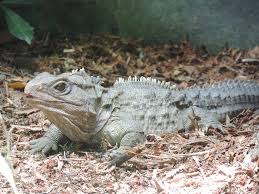 Another animal only found in New Zealand is the Tuatara. It is a medium-size reptile sadly in danger of becoming extinct. Although tuatara originally lived on the mainland it is now only found in the wild, on 32 of New Zealand’s islands.
Another animal only found in New Zealand is the Tuatara. It is a medium-size reptile sadly in danger of becoming extinct. Although tuatara originally lived on the mainland it is now only found in the wild, on 32 of New Zealand’s islands.
Tuatara is the only surviving species of a large group of reptiles, the Order Spedodontia, which were in existence around 200 million years ago when dinosaurs roamed the earth. All other species had died out by about 60 million years ago, leaving the tuatara as a kind of ‘living fossil’. As a result, they are of great interest to scientists all over the world.
The Tuatara appears to be very similar to lizards but is, in fact, different – they mate differently and have an unusual arrangement of teeth that enables them to tear apart their food. They are a medium size reptile (weighing males weigh up to 1kg, females 65% of that) and most notably have a ‘third eye’ which is a gland under the skin on the top of their head. This develops from birth, is covered with scales after three to four months and enables the tuatara to soak up Vitamin D through the sun’s UV rays. However, they can also regrow their tales if they ever lose them, in the same way as lizards.
The name tuatara comes from the Maori words for ‘peaks on the back’ – referring to the animal’s dorsal spines. The tuatara is extremely rare due to predators –introduced mammals and rodents have been their greatest enemy, threatening on tuatara eggs and young, as well as eating their food supplies. Fires and poaching have also threatened them
They reproduce very slowly – the female is only ready to mate every 2 to five years with the eggs hatching after 11 to 16 months. There is a vigorous conservation programme which has included eradicating mammals (especially rats) from the islands, thereby protecting the population. There is a population of about 50,000 living on Stephen’s Island and the Trios Group of islands in the Marlborough Sound, with other populations on other islands although there are mainland sanctuaries where tuatara are bred in captivity.
There are some very unusual facts about tuatara – they usually have a life span of 60 years but can live to 100 years old. They have a range of colours from khaki green to brown to orange-red, and can also alter their colour throughout their life span. They are nocturnal creatures, but young tuatara often hunt during the day to avoid being eaten themselves by the adults!
